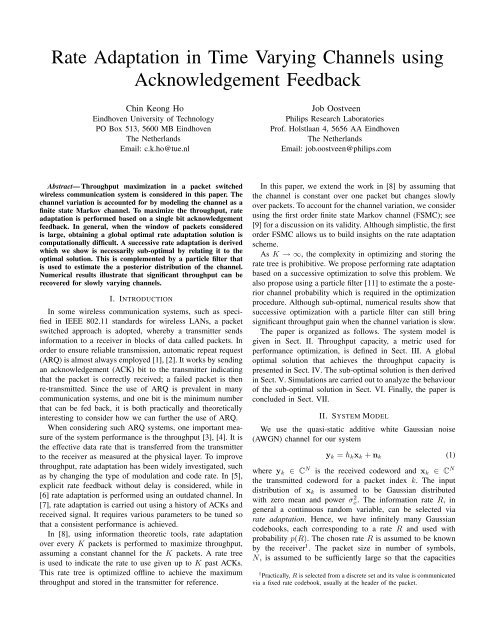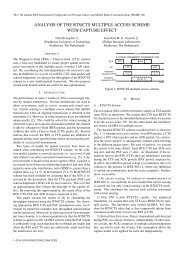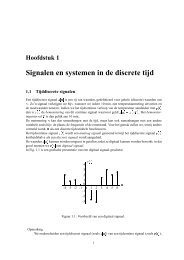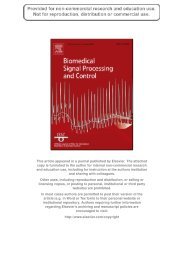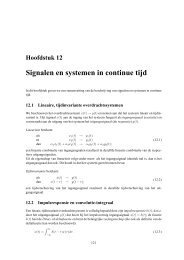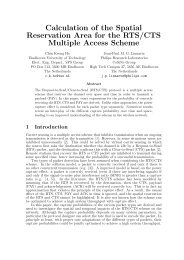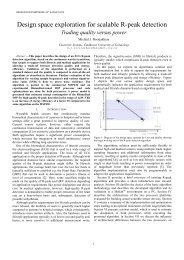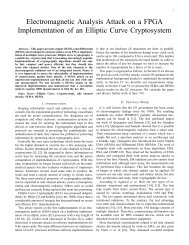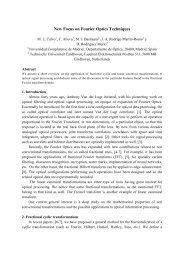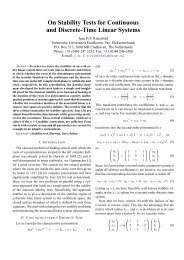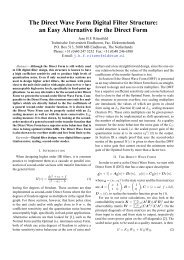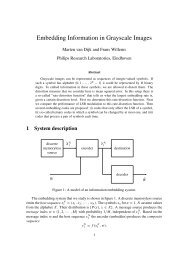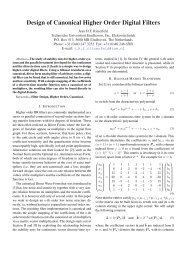Rate Adaptation in Time Varying Channels using Acknowledgement ...
Rate Adaptation in Time Varying Channels using Acknowledgement ...
Rate Adaptation in Time Varying Channels using Acknowledgement ...
Create successful ePaper yourself
Turn your PDF publications into a flip-book with our unique Google optimized e-Paper software.
<strong>Rate</strong> <strong>Adaptation</strong> <strong>in</strong> <strong>Time</strong> Vary<strong>in</strong>g <strong>Channels</strong> us<strong>in</strong>g<br />
<strong>Acknowledgement</strong> Feedback<br />
Ch<strong>in</strong> Keong Ho<br />
E<strong>in</strong>dhoven University of Technology<br />
PO Box 513, 5600 MB E<strong>in</strong>dhoven<br />
The Netherlands<br />
Email: c.k.ho@tue.nl<br />
Job Oostveen<br />
Philips Research Laboratories<br />
Prof. Holstlaan 4, 5656 AA E<strong>in</strong>dhoven<br />
The Netherlands<br />
Email: job.oostveen@philips.com<br />
Abstract— Throughput maximization <strong>in</strong> a packet switched<br />
wireless communication system is considered <strong>in</strong> this paper. The<br />
channel variation is accounted for by model<strong>in</strong>g the channel as a<br />
f<strong>in</strong>ite state Markov channel. To maximize the throughput, rate<br />
adaptation is performed based on a s<strong>in</strong>gle bit acknowledgement<br />
feedback. In general, when the w<strong>in</strong>dow of packets considered<br />
is large, obta<strong>in</strong><strong>in</strong>g a global optimal rate adaptation solution is<br />
computationally difficult. A successive rate adaptation is derived<br />
which we show is necessarily sub-optimal by relat<strong>in</strong>g it to the<br />
optimal solution. This is complemented by a particle filter that<br />
is used to estimate the a posterior distribution of the channel.<br />
Numerical results illustrate that significant throughput can be<br />
recovered for slowly vary<strong>in</strong>g channels.<br />
I. INTRODUCTION<br />
In some wireless communication systems, such as specified<br />
<strong>in</strong> IEEE 802.11 standards for wireless LANs, a packet<br />
switched approach is adopted, whereby a transmitter sends<br />
<strong>in</strong>formation to a receiver <strong>in</strong> blocks of data called packets. In<br />
order to ensure reliable transmission, automatic repeat request<br />
(ARQ) is almost always employed [1], [2]. It works by send<strong>in</strong>g<br />
an acknowledgement (ACK) bit to the transmitter <strong>in</strong>dicat<strong>in</strong>g<br />
that the packet is correctly received; a failed packet is then<br />
re-transmitted. S<strong>in</strong>ce the use of ARQ is prevalent <strong>in</strong> many<br />
communication systems, and one bit is the m<strong>in</strong>imum number<br />
that can be fed back, it is both practically and theoretically<br />
<strong>in</strong>terest<strong>in</strong>g to consider how we can further the use of ARQ.<br />
When consider<strong>in</strong>g such ARQ systems, one important measure<br />
of the system performance is the throughput [3], [4]. It is<br />
the effective data rate that is transferred from the transmitter<br />
to the receiver as measured at the physical layer. To improve<br />
throughput, rate adaptation has been widely <strong>in</strong>vestigated, such<br />
as by chang<strong>in</strong>g the type of modulation and code rate. In [5],<br />
explicit rate feedback without delay is considered, while <strong>in</strong><br />
[6] rate adaptation is performed us<strong>in</strong>g an outdated channel. In<br />
[7], rate adaptation is carried out us<strong>in</strong>g a history of ACKs and<br />
received signal. It requires various parameters to be tuned so<br />
that a consistent performance is achieved.<br />
In [8], us<strong>in</strong>g <strong>in</strong>formation theoretic tools, rate adaptation<br />
over every K packets is performed to maximize throughput,<br />
assum<strong>in</strong>g a constant channel for the K packets. A rate tree<br />
is used to <strong>in</strong>dicate the rate to use given up to K past ACKs.<br />
This rate tree is optimized offl<strong>in</strong>e to achieve the maximum<br />
throughput and stored <strong>in</strong> the transmitter for reference.<br />
In this paper, we extend the work <strong>in</strong> [8] by assum<strong>in</strong>g that<br />
the channel is constant over one packet but changes slowly<br />
over packets. To account for the channel variation, we consider<br />
us<strong>in</strong>g the first order f<strong>in</strong>ite state Markov channel (FSMC); see<br />
[9] for a discussion on its validity. Although simplistic, the first<br />
order FSMC allows us to build <strong>in</strong>sights on the rate adaptation<br />
scheme.<br />
As K →∞, the complexity <strong>in</strong> optimiz<strong>in</strong>g and stor<strong>in</strong>g the<br />
rate tree is prohibitive. We propose perform<strong>in</strong>g rate adaptation<br />
based on a successive optimization to solve this problem. We<br />
also propose us<strong>in</strong>g a particle filter [11] to estimate the a posterior<br />
channel probability which is required <strong>in</strong> the optimization<br />
procedure. Although sub-optimal, numerical results show that<br />
successive optimization with a particle filter can still br<strong>in</strong>g<br />
significant throughput ga<strong>in</strong> when the channel variation is slow.<br />
The paper is organized as follows. The system model is<br />
given <strong>in</strong> Sect. II. Throughput capacity, a metric used for<br />
performance optimization, is def<strong>in</strong>ed <strong>in</strong> Sect. III. A global<br />
optimal solution that achieves the throughput capacity is<br />
presented <strong>in</strong> Sect. IV. The sub-optimal solution is then derived<br />
<strong>in</strong> Sect. V. Simulations are carried out to analyze the behaviour<br />
of the sub-optimal solution <strong>in</strong> Sect. VI. F<strong>in</strong>ally, the paper is<br />
concluded <strong>in</strong> Sect. VII.<br />
II. SYSTEM MODEL<br />
We use the quasi-static additive white Gaussian noise<br />
(AWGN) channel for our system<br />
y k = h k x k + n k (1)<br />
where y k ∈ C N is the received codeword and x k ∈ C N<br />
the transmitted codeword for a packet <strong>in</strong>dex k. The <strong>in</strong>put<br />
distribution of x k is assumed to be Gaussian distributed<br />
with zero mean and power σx. 2 The <strong>in</strong>formation rate R, <strong>in</strong><br />
general a cont<strong>in</strong>uous random variable, can be selected via<br />
rate adaptation. Hence, we have <strong>in</strong>f<strong>in</strong>itely many Gaussian<br />
codebooks, each correspond<strong>in</strong>g to a rate R and used with<br />
probability p(R). The chosen rate R is assumed to be known<br />
by the receiver 1 . The packet size <strong>in</strong> number of symbols,<br />
N, is assumed to be sufficiently large so that the capacities<br />
1 Practically, R is selected from a discrete set and its value is communicated<br />
via a fixed rate codebook, usually at the header of the packet.
and <strong>in</strong>formation outages def<strong>in</strong>ed throughout this paper are<br />
achievable. The complex channel h k , with variance σh 2 , is time<br />
<strong>in</strong>variant for each packet but varies across packets. The noise<br />
vector n k ∈ C N is AWGN with variance σn.<br />
2<br />
If a packet is not received correctly, an outage is said<br />
to occur. Practically, this <strong>in</strong>formation is available at the receiver<br />
via a cyclic redundancy check (CRC) at the medium<br />
access control (MAC) layer. The packet is either discarded<br />
or re-transmitted later <strong>in</strong> non-delay sensitive applications.<br />
The present packet therefore fails to deliver the data bits<br />
and the <strong>in</strong>stantaneous throughput is zero. Otherwise, if the<br />
packet is received correctly, the <strong>in</strong>stantaneous throughput, <strong>in</strong><br />
bit/symbols, equals the data rate. The throughput for the k th<br />
packet is therefore def<strong>in</strong>ed as<br />
T (¯γ,R k ,h k )=R k × (1 − ɛ(¯γ|R k ,h k )) (2)<br />
where ɛ(¯γ|R k ,h k ) is the outage probability at an average SNR<br />
¯γ = σ 2 h σ2 x/σ 2 n for a given R k and h k . The actual outage<br />
probability function depends on the error correction code used.<br />
We treat every K packets as one basic unit: a K-packet.<br />
The throughput of a K-packet system with average SNR ¯γ<br />
can be generally def<strong>in</strong>ed as<br />
T K (¯γ,r K , h K )= 1 K<br />
K∑<br />
T (¯γ,R k ,h k ) (3)<br />
k=1<br />
where h K =[h 1 h 2 ···h K ] and the rate vector is given by<br />
r K =[R 1 R 2 ···R K ].TherateR k determ<strong>in</strong>es the throughput<br />
of packet k as reflected <strong>in</strong> (3). Interest<strong>in</strong>g, the rate also affects<br />
the ability of the transmitter to observe the channel, or CSI,<br />
via the ACK feedback - this will become apparent <strong>in</strong> the next<br />
section.<br />
III. THROUGHPUT CAPACITY<br />
A. Full Channel State Information (CSI)<br />
We are <strong>in</strong>terested <strong>in</strong> maximiz<strong>in</strong>g the average throughput<br />
of (3) us<strong>in</strong>g a packet-by-packet rate adaption scheme. The<br />
throughput capacity, or the maximum throughput achievable<br />
over the jo<strong>in</strong>t distribution of the rate and channel, is def<strong>in</strong>ed<br />
as<br />
CT K [<br />
,full CSI(¯γ) = sup E rK,h K T K (¯γ,r K , h K ) ]<br />
p(r K,h K)<br />
[<br />
= sup E rK,h K T K (¯γ,r K , h K ) ] (4)<br />
p(r K|h K)<br />
where E is the expectation operator (over the distribution<br />
given by its subscript). Here, for full generality, we assume<br />
that the rate is a random variable for which we want to<br />
f<strong>in</strong>d the optimal distribution. The second l<strong>in</strong>e follows s<strong>in</strong>ce<br />
p(r K , h K )=p(r K |h K )p(h K ) and p(h K ) is related to the<br />
channel and is not a parameter available for maximization. It<br />
turns out that to achieve the throughput capacity without any<br />
restriction, full CSI via h K is required at the transmitter.<br />
In practice, full CSI is not available, and also there is a<br />
delay <strong>in</strong> obta<strong>in</strong><strong>in</strong>g the CSI. A more general def<strong>in</strong>ition for the<br />
case that a partial CSI is known at the transmitter follows.<br />
B. Partial CSI<br />
In general, we want to maximize the throughput us<strong>in</strong>g rate<br />
adaption given a partial channel knowledge expressed as a<br />
random parameter a (which can be discrete or cont<strong>in</strong>uous,<br />
scalar or vector). The distribution available for maximization<br />
is therefore restricted to p(r K |a). However, we now need to<br />
take <strong>in</strong>to account the extra random variable a <strong>in</strong> perform<strong>in</strong>g<br />
the expectation <strong>in</strong> (4). This gives us the throughput capacity<br />
CT K [<br />
(¯γ) = sup E rK,h K,a T K (¯γ,r K , h K ) ] . (5)<br />
p(r K|a)<br />
This formulation reduces to (4) when a = h K . The case when<br />
no channel knowledge is available can be treated by lett<strong>in</strong>g a<br />
be an empty vector <strong>in</strong> (5). The special case when the channel<br />
is constant over K packets can be treated by sett<strong>in</strong>g h k = h<br />
for all k, which is considered <strong>in</strong> [8].<br />
We now consider the case of <strong>in</strong>terest here <strong>in</strong> us<strong>in</strong>g (5). In<br />
the MAC protocol, the simplest feedback provided is via a<br />
ACK or negative ACK, i.e. NACK. This is a form of partial<br />
CSI. Specifically, denote the CSI of packet k as A k with value<br />
1 for ACK and 0 for NACK. Their probabilities are<br />
p(A k =1|R k ,h k )=1− ɛ(¯γ|R k ,h k ), (6)<br />
p(A k =0|R k ,h k )=ɛ(¯γ|R k ,h k ). (7)<br />
Obviously, A k is dependent on R k , s<strong>in</strong>ce if R k is large, the<br />
possibility of A k =0is high. For the ARQ system, we can<br />
replace a <strong>in</strong> (5) by the ACK vector a K−1 , where we denote<br />
a k−1 [a k−2 ,A k−1 ],k = 2, 3, ··· , and a 0 is an empty<br />
vector.<br />
On the other hand, not all of the ACKs and rates are always<br />
available for rate adaptation due to a causality constra<strong>in</strong>t. The<br />
<strong>in</strong>formation available at packet k is only a k−1 and r k−1 .Tobe<br />
exact, R k should then be written explicitly as 2 R k (a k−1 , r k−1 )<br />
when substitut<strong>in</strong>g (3) <strong>in</strong>to (5). Similarly, the rate vector should<br />
be understood as dependent on the the past ACKs and rates,<br />
<strong>in</strong> the form of r k (a k−1 , r k−1 ). However, the argument will be<br />
dropped when there is no ambiguity.<br />
IV. GLOBAL OPTIMIZATION<br />
A global optimization approach is required to realize (5)<br />
which can be re-written us<strong>in</strong>g Bayes’ rule as<br />
CT K (¯γ) (8)<br />
[<br />
= sup E aK−1 E rK|a K−1<br />
E hK|a K−1,r K−1 T K (¯γ,r K , h K ) ] .<br />
p(r K|a K−1)<br />
It is shown <strong>in</strong> [8] that the optimal rate for packet k, denoted as<br />
Rk o, is determ<strong>in</strong>istic, but still depends on a k−1. S<strong>in</strong>ce A k has<br />
two possibilities, i.e. |A| =2, then there exist ∑ K−1<br />
k=0 |A|k =<br />
2 K − 1 dist<strong>in</strong>ct rates to account for all possible a K−1 .The<br />
rate be<strong>in</strong>g determ<strong>in</strong>istic has two implications. First, we need<br />
to perform a jo<strong>in</strong>t maximization over just one modified rate<br />
vector conta<strong>in</strong><strong>in</strong>g all possible rates, say r all , rather than over<br />
2 Strictly speak<strong>in</strong>g, R k is a random variable and should not be written as<br />
a function of other variables. We stick to this notation for conciseness. We<br />
show later that the optimal rate is <strong>in</strong>deed a determ<strong>in</strong>istic function.
a conditional distribution p(r K |a K−1 ). Second, we need not<br />
perform the expectations over the rates. Hence, (8) becomes<br />
CT K (¯γ)=sup Tave(¯γ,r K<br />
all ),<br />
(9a)<br />
r all<br />
Tave(¯γ,r K<br />
[<br />
all )E aK−1 E hK|a K−1,r K−1 T K (¯γ,r K , h K ) ] .(9b)<br />
The global solution can be computed off-l<strong>in</strong>e and used for<br />
rate adaptation over every K packets. However, the size of<br />
r all grows large quickly when K is large, result<strong>in</strong>g <strong>in</strong> a high<br />
complexity of O(|A| K ). Unless a simple optimization procedure<br />
can be found, which is not expected for general channels,<br />
obta<strong>in</strong><strong>in</strong>g an optimum solution is computationally difficult.<br />
Another problem, though less severe, is the requirement of<br />
large storage of the rates based on all possible a K−1 .<br />
V. SUB-OPTIMAL RATE ADAPTATION<br />
The high computational complexity of f<strong>in</strong>d<strong>in</strong>g globally<br />
optimal rates motivates us to look for another sub-optimal approach.<br />
The alternative solution should ideally yield a simple<br />
optimization criterion, preferably be calculated easily onl<strong>in</strong>e<br />
and most importantly, yield high throughput.<br />
A. Successive Optimization<br />
First, we need to massage the throughput capacity to a<br />
more enlighten<strong>in</strong>g form. The total throughput capacity can<br />
be decomposed us<strong>in</strong>g (3) <strong>in</strong> (9), so that each summand<br />
corresponds to the throughput on a packet-by-packet basis:<br />
[<br />
]<br />
K × CT K (¯γ)=sup f(R 1 )+E A1 sup f(R 2 , r 1 , a 1 )<br />
R 1 R 2<br />
]<br />
+E A2|a 1<br />
[sup f(R 3 , r 2 , a 2 ) + ··· (10)<br />
R 3<br />
where f(R k , r k−1 , a k−1 ) E hk |r k−1 ,a k−1<br />
[T (¯γ,R k ,h k )].<br />
Here, the sup operator has been brought <strong>in</strong>to the expectation<br />
for packet 2 and onwards as a result of the causality of the<br />
ACKs.<br />
As seen from (10), s<strong>in</strong>ce a 1 = A 1 depends on R 1 ,the<br />
choice of R 1 affects the throughput of packets 2, 3, ···. Similarly,<br />
R 2 affects the throughput of latter packets via A 2 , and so<br />
on. Hence, the optimal choice of R k will affect all subsequent<br />
packets due to A k . By mak<strong>in</strong>g the (<strong>in</strong>valid) assumption that<br />
A k is <strong>in</strong>dependent of R k , the optimization from packet to<br />
packet <strong>in</strong> (10) is then decoupled. This resulted <strong>in</strong> the solution<br />
when R k is optimized by treat<strong>in</strong>g previous rates and partial<br />
channel <strong>in</strong>formation as given parameters. We then maximize<br />
the average throughput for the current packet, without regard<br />
as to how it will affect future throughput. The rate chosen<br />
may not reveal sufficient <strong>in</strong>formation about the channel via<br />
the ACK/NACK and hence may be detrimental to the overall<br />
throughput.<br />
We call this sub-optimal rate adaptation solution as successive<br />
optimization, given formally as<br />
R sub<br />
k<br />
=argsup<br />
R k<br />
E hk |a k−1 ,r k−1<br />
[T (¯γ,R k ,h k )] . (11)<br />
Although sub-optimal (11) still allows us to <strong>in</strong>clude the<br />
<strong>in</strong>formation about past rates and ACKs for rate adaptation.<br />
Furthermore, the successive optimization can be viewed as a<br />
method to select a rate for the current packet without regard<br />
as to how past rates and a partial CSI are obta<strong>in</strong>ed. Hence, we<br />
may even use an arbitrary rate adaptation strategy (for some<br />
other reason) before switch<strong>in</strong>g to this solution.<br />
B. Particle Filter<br />
To perform onl<strong>in</strong>e rate optimization us<strong>in</strong>g (11) requires<br />
the knowledge of p(h k |r k−1 , a k−1 ). This probability density<br />
function (PDF) gives a probabilistic description of the channel<br />
given some knowledge of the past channels. In general, this<br />
PDF cannot be easily determ<strong>in</strong>ed analytically. To obta<strong>in</strong> a<br />
tractable solution, we propose consider<strong>in</strong>g a class of channel<br />
model known as the FSMC. It is assumed <strong>in</strong> this model that<br />
the channel is discrete and follows a first order Markovian<br />
process. The partial channel <strong>in</strong>formation A k can be viewed as<br />
an observation of the channel h k . By def<strong>in</strong><strong>in</strong>g p(h 1 |h −1 )=<br />
p(h 1 ), the jo<strong>in</strong>t PDF can then be factored as<br />
p(h K , a K |r K )=<br />
K∏<br />
p(h k |h k−1 )p(A k |R k ,h k ). (12)<br />
k=1<br />
This is known commonly as the hidden Markov model [10].<br />
To expose the capability of the sub-optimal approach, we<br />
use a particle filter to compute the PDF. The particle filter<br />
[11], made popular as a sampl<strong>in</strong>g importance resampl<strong>in</strong>g (SIR)<br />
filter <strong>in</strong> [12], approximates a PDF by recursive importance<br />
sampl<strong>in</strong>g of random samples known as particles. By exploit<strong>in</strong>g<br />
the structure of (12), the particle filter estimates the a posterior<br />
probability p(h k |a K−1 , r K−1 ) as required for comput<strong>in</strong>g the<br />
expectation <strong>in</strong> (11). A computational cost <strong>in</strong> the order of the<br />
number of particles is required, rather than on the length of<br />
observations. Hence, we can let K →∞<strong>in</strong> the successive<br />
optimization and takes all past partial CSI <strong>in</strong>to account.<br />
VI. SIMULATION RESULTS<br />
A. Scenario<br />
We consider the follow<strong>in</strong>g scenario for our simulations.<br />
1) Channel: The degree of the channel variation over time<br />
depends on the transition probability p(h k |h k−1 ), assumed to<br />
be stationary and known. We assume that (h k ,h k−1 ) is a<br />
bivariate circularly symmetric complex Gaussian distribution<br />
with correlation coefficient ρ = E[h k h ∗ k−1 ]/σ2 h .<br />
For most applications, <strong>in</strong>clud<strong>in</strong>g the one described next,<br />
we are only <strong>in</strong>terested <strong>in</strong> the channel amplitudes (which are<br />
Rayleigh distributed). Hence, we let r k = |h k | and we work<br />
only with the distribution of r k us<strong>in</strong>g the FSMC [9]. Furthermore,<br />
we approximate the channel r k us<strong>in</strong>g discrete values<br />
from 0 to 5 <strong>in</strong> steps of 0.01, which is experimentally found to<br />
be have sufficient accuracy <strong>in</strong> represent<strong>in</strong>g the channel when<br />
¯γ =0dB. At other SNR, the <strong>in</strong>stantaneous SNR is scaled<br />
accord<strong>in</strong>gly so that we can still use the same Rayleigh PDF<br />
with ¯γ =0dB. The bivariate rayleigh PDF and the cumulative<br />
distribution function (CDF) of (r k ,r k−1 ) can be specified by<br />
E[r<br />
the power correlation coefficient ρ r 2 =<br />
2 k r2 k−1<br />
√ ]<br />
The<br />
E[r 4<br />
k ]E[rk−1 4 ].<br />
CDF is represented as a power series <strong>in</strong> [13] for the Rayleigh
fad<strong>in</strong>g channel. It can be shown that the two correlation<br />
coefficients are related as ρ r 2 = ρ 2 [14]. We shall use ρ as<br />
the parameter to describe the rate of channel variation.<br />
2) Outage: For the purpose of simulations, we assume that<br />
an outage occurs if and only if an <strong>in</strong>formation outage occurs,<br />
i.e.<br />
ɛ(¯γ|R, h) =Pr(R>C <strong>in</strong>st (h)) = I (R >C <strong>in</strong>st (h)) (13)<br />
where C <strong>in</strong>st (h) = log 2<br />
(<br />
1+|h|<br />
2 ) is the Shannon capacity and<br />
I (E) is the <strong>in</strong>dicator function which has the value 1 when the<br />
event E is true and 0 otherwise. S<strong>in</strong>ce the maximum rate that<br />
can be reliably transmitted is given by the Shannon capacity,<br />
the throughput capacity obta<strong>in</strong>ed us<strong>in</strong>g (13) is the maximum<br />
possible (over all Gaussian codes). By us<strong>in</strong>g (6), (7) and (13),<br />
together with the transition probability p(h k |h k−1 ), (12) can<br />
be fully specified.<br />
Throughput<br />
7<br />
6<br />
5<br />
4<br />
3<br />
2<br />
1<br />
0<br />
0 5 10 15 20 25 30<br />
SNR (dB)<br />
ρ =0.64<br />
ρ =1<br />
ρ =0.90<br />
ρ =0.98<br />
B. Throughput Degradation with Mismatched ρ<br />
We consider the effect of us<strong>in</strong>g rate adaptation designed for<br />
ρ =1when actually ρ
Throughput<br />
5<br />
4.8<br />
4.6<br />
4.4<br />
4.2<br />
4<br />
3.8<br />
3.6<br />
Realized throughput<br />
us<strong>in</strong>g particle filter<br />
benchmark:<br />
throughput capacity<br />
achieved with no CSI<br />
3.4<br />
0 100 200 300 400 500 600 700 800 900 1000<br />
Packet <strong>in</strong>dex k<br />
100 particles, ρ =0.99<br />
100 particles, ρ =0.98<br />
100 particles, ρ =0.90<br />
Fig. 3. Throughput achieved us<strong>in</strong>g successive rate adaptation over time;<br />
¯γ =20dB.<br />
Throughput<br />
8<br />
7<br />
6<br />
5<br />
4<br />
3<br />
2<br />
1<br />
successive optimization,<br />
100 particles, ρ =0.99<br />
successive optimization,<br />
100 particles, ρ =0.98<br />
maximum possible:<br />
throughput capacity<br />
achieved with full CSI<br />
0<br />
0 5 10 15 20 25 30<br />
Fig. 4.<br />
SNR (dB)<br />
benchmark:<br />
throughput capacity<br />
achieved with no CSI<br />
Comparison of the successive optimization for different SNR.<br />
aged over 100 runs, is plotted <strong>in</strong> Fig. 4 for different SNR. For<br />
the ρ values shown here, it is worthwhile us<strong>in</strong>g successive<br />
optimization. For example, to achieve a throughput of 4<br />
bits/symbol when ρ =0.98 requires about 2.5dB less SNR<br />
as compared to the benchmark. However, some problem for<br />
improvement may still be possible. In Fig. 4, the maximum<br />
achievable throughput capacity with full CSI (as computed <strong>in</strong><br />
[8]) is still significantly higher. We envision that rate adaptation<br />
us<strong>in</strong>g more advanced cod<strong>in</strong>g schemes with <strong>in</strong>cremental<br />
redundancy, rather than <strong>in</strong>dependent packet by packet cod<strong>in</strong>g<br />
used here, would close that gap further.<br />
VII. CONCLUSION<br />
For packet switched systems with time vary<strong>in</strong>g channels, the<br />
global optimal rate adaptation scheme is practically difficult to<br />
f<strong>in</strong>d or implement. We propose a sub-optimal rate adaptation<br />
solution which uses successive optimization, implemented<br />
with a particle filter for estimat<strong>in</strong>g the required channel a posteriori<br />
probability. In a f<strong>in</strong>ite state Markov channel with slow<br />
time variation, the technique recovers a substantial amount of<br />
throughput compared to the case when a fixed optimized rate is<br />
selected for each SNR. Observations on realizations of the rate<br />
adaptation scheme also br<strong>in</strong>g forth a sensible general strategy.<br />
When a NACK is received, decrease rate rapidly; when an<br />
ACK is received, <strong>in</strong>crease rate cautiously if the rate is already<br />
high or decrease the rate aggressively if the rate is low.<br />
APPENDIX<br />
Us<strong>in</strong>g (2), (3) and (6), the throughput (9) can be computed<br />
as<br />
T K<br />
ave(¯γ,r all )=<br />
1<br />
K∑ ∑<br />
∫<br />
R k × p(A k =1|R k ,h k )p(h k , a k−1 )dh k (14)<br />
K<br />
k=1 a k<br />
h k<br />
for discrete a k and cont<strong>in</strong>uous h k . With (12), the throughput<br />
can be calculated if the <strong>in</strong>itial probability p(h 1 ), the transition<br />
probability p(h k |h k−1 ) and the outage probability p(A k =<br />
1|h k ) is specified.<br />
REFERENCES<br />
[1] J. M. Wozencraft and M. Horste<strong>in</strong>, “Cod<strong>in</strong>g for two-way channels,” Res.<br />
Lab. Electron., MIT, Cambridge, MA, Tech. Rep. 383, Jan. 1961.<br />
[2] P. S<strong>in</strong>dhu, “Retransmission error control with memory,” IEEE Trans.<br />
Commun., vol. 25, no. 5, pp. 473–479, May 1977.<br />
[3] L. L<strong>in</strong>, R. D. Yates, and P. Spasojevic, “Adaptive transmission with<br />
discrete code rates and power levels,” IEEE Trans. Commun., vol. 51,<br />
no. 12, pp. 2115–2125, Dec. 2003.<br />
[4] G. Caire and D. Tun<strong>in</strong>etti, “The throughput of hybrid-ARQ protocols for<br />
the Gaussian collision channel,” IEEE Trans. Inform. Theory, vol. 47,<br />
no. 5, pp. 1971–1988, July 2001.<br />
[5] Q. Liu, S. Zhou, and G. Giannakis, “Cross-layer comb<strong>in</strong><strong>in</strong>g of adaptive<br />
modulation and cod<strong>in</strong>g with truncated ARQ over wireless l<strong>in</strong>ks,” IEEE<br />
Trans. Wireless Commun., vol. 3, no. 5, pp. 1746–1755, Sept. 2004.<br />
[6] D. L. Goeckel, “Adaptive cod<strong>in</strong>g for time-vary<strong>in</strong>g channels us<strong>in</strong>g<br />
outdated fad<strong>in</strong>g estimates,” IEEE Trans. Commun., vol. 47, no. 6, pp.<br />
844–855, June 1999.<br />
[7] J. del Prado Pavon and S. Choi, “L<strong>in</strong>k adaptation strategy for IEEE<br />
802.11 WLAN via received signal strength measurement,” <strong>in</strong> Proc. IEEE<br />
ICC ’03, vol. 2, Anchorage, Alaska, USA, May 2003, pp. 1108–1113.<br />
[8] C. K. Ho, F. Willems, and J. Oostveen, “Maximiz<strong>in</strong>g throughput<br />
of packet switched wireless communication systems,” <strong>in</strong> Forty-third<br />
Allerton Conf., Sept. 2005.<br />
[9] C. C. Tan and N. C. Beaulieu, “On first-order Markov model<strong>in</strong>g for the<br />
Rayleigh fad<strong>in</strong>g channels,” IEEE Trans. Commun., vol. 48, no. 12, pp.<br />
2032–2040, Dec. 2000.<br />
[10] L. R. Rab<strong>in</strong>er, “A tutorial on hidden Markov models and selected<br />
applications <strong>in</strong> speech recognition,” Proc. IEEE, vol. 77, no. 2, pp. 257–<br />
286, Feb. 1989.<br />
[11] M. S. Arulampalam, S. Maskell, N. Gordon, and T. Clapp, “A tutorial<br />
on particle filters for onl<strong>in</strong>e nonl<strong>in</strong>ear/non-Gaussian Bayesian track<strong>in</strong>g,”<br />
IEEE Trans. Signal Process<strong>in</strong>g, vol. 50, no. 2, pp. 174–188, Feb. 2002.<br />
[12] N. Gordon, D. Salmond, and A. F. M. Smith, “Novel approach to<br />
nonl<strong>in</strong>ear/non-Gaussian Bayesian state estimation,” Radar and Signal<br />
Process<strong>in</strong>g, IEE Proceed<strong>in</strong>gs F, vol. 140, no. 2, pp. 107–113, Apr. 1993.<br />
[13] C. C. Tan and N. C. Beaulieu, “Inf<strong>in</strong>ite series representations of<br />
the bivariate Rayleigh and Nakagami-m distributions,” IEEE Trans.<br />
Commun., vol. 45, no. 10, pp. 1159–1161, Oct. 1997.<br />
[14] R. Mallik, “On multivariate Rayleigh and exponential distributions,”<br />
IEEE Trans. Inform. Theory, vol. 49, no. 6, pp. 1499–1515, June 2003.


